Understanding Manual Rubbish Compactors: Your Ultimate Guide

Introduction to Manual Rubbish Compactors
Manual rubbish compactors are essential tools designed to reduce the volume of waste material. Whether you’re looking to save space or reduce the frequency of garbage disposal, a manual rubbish compactor can be a great investment for households and businesses alike. This comprehensive guide will delve into what manual rubbish compactors are, how they work, their benefits, and practical tips on choosing and using one effectively.
What is a Manual Rubbish Compactor?
A manual rubbish compactor is a device that compresses waste to take up less space. Unlike automatic compactors, which operate using electricity, manual compactors rely on human effort to compress the rubbish. This makes them suitable for various environments where electricity may not be readily available.
How Does a Manual Rubbish Compactor Work?
The device operates on a simple principle: a lever or a hand-operated mechanism is used to apply force to the waste material, compacting it into a smaller volume. The process typically involves placing rubbish inside the compactor, applying pressure using the handle or lever, and then emptying the compacted waste into a bin or bag.
Benefits of Using a Manual Rubbish Compactor
1. Space Saving
One of the primary benefits of manual rubbish compactors is their ability to significantly reduce the volume of waste, making it easier to manage space in kitchens, offices, and workplaces.
2. Cost-Effective Waste Management
By minimizing the volume of waste, manual compactors can help reduce the frequency and costs associated with garbage collection services.
3. Environmentally Friendly
Using a manual rubbish compactor can lead to reduced waste production and lower carbon footprints due to fewer trips to waste disposal sites.
4. Portable and Easy to Use
Many manual compactors are lightweight and portable, making them easy to transport between different locations. Their straightforward operation requires minimal training, making them user-friendly.
Types of Manual Rubbish Compactors
1. Handheld Compactors
Handheld compactors are small, lightweight tools designed for personal use. They are ideal for compacting smaller items like food waste or packaging materials.
2. Floor-Mounted Compactors
These compactors are larger and more robust, suitable for commercial use. They can handle larger volumes of waste and are often found in kitchens, workshops, and factories.
3. Bin Compactors
Bin compactors are designed to fit on top of standard trash bins. Users insert waste into the bin, and then the compactor compresses the material down, allowing for more waste to fit into the bin.

How to Choose the Right Manual Rubbish Compactor

1. Consider Waste Volume
Determine the typical amount of waste you generate. For households, a smaller handheld model may suffice, while businesses might require a more substantial floor-mounted option.
2. Material Compatibility
Check the type of waste materials you need to compress. Some compactors are better suited for specific materials, such as cardboard, while others can handle a variety.
3. Size and Portability
Evaluate the space where the compactor will be used. If space is limited, opt for a compact, portable model. For larger areas, consider more substantial, stationary units.
4. Durability and Build Quality
Look for models made from strong, durable materials to ensure longevity, especially if using for commercial purposes.
5. Ease of Use
Choose a compactor that is simple to operate. Check reviews to find models that provide clear instructions and uncomplicated mechanisms.
Practical Tips for Using a Manual Rubbish Compactor
1. Sort Waste Before Compaction
To maximize efficiency, sort your waste. Remove any items that cannot be recycled or compacted, as this will improve the overall sanitation and function of the compactor.
2. Do Not Overfill
Always adhere to the maximum fill level of your compactor. Overfilling can lead to inefficient compaction and potential damage to the machine.
3. Clean Regularly
Maintain hygiene by cleaning the compactor regularly. This prevents odors and promotes a healthier environment.
4. Use Protective Gear
When handling waste materials, always wear gloves and a mask to protect yourself from germs and pathogens.
How to Maintain Your Manual Rubbish Compactor
1. Regular Inspections
Periodically inspect your compactor for wear and tear. This helps identify problems before they worsen.
2. Lubrication
Apply lubricant to moving parts as recommended by the manufacturer to ensure smooth operation and prevent rust or sticking.
3. Repair When Necessary
If you find any issues, such as dents or broken components, address them immediately to prevent further damage.
4. Store Properly
Store your compactor in a dry location to avoid exposure to elements that may cause damage.
Common Misconceptions About Manual Rubbish Compactors

1. They Are Inefficient
Some users believe manual compactors are less efficient compared to electric models. However, with proper technique, manual compactors can compress waste effectively.
2. Only Suitable for Small Waste
While manual compactors can handle smaller items, many models are designed to manage various types of waste, including larger cardboard boxes.
3. Difficult to Use
Many individuals think that manual compactors require significant strength. Most models are designed for easy operation, emphasizing user-friendly mechanisms.
Frequently Asked Questions (FAQ)
1. What materials can I compact using a manual rubbish compactor?
You can compact a variety of materials, including cardboard, paper, plastics, and organic waste. However, avoid compacting hazardous materials or large, solid items that may damage the machine.
2. How often should I clean my manual rubbish compactor?
It is advisable to clean your compactor at least once a week to prevent odors and maintain hygienic conditions.
3. Can I use a manual rubbish compactor for recycling purposes?
Yes, manual rubbish compactors can be effectively used for recycling. Compacted recyclable materials take up less space, making transportation to recycling centers more efficient.
4. Are manual rubbish compactors expensive?
The cost of manual rubbish compactors varies widely, but they typically range from $50 to $500, depending on size, durability, and features. Always check multiple sources to find one that fits your budget.
5. Is it safe to use a manual rubbish compactor?
Yes, when used properly, manual rubbish compactors are safe. Always follow the manufacturer’s instructions and wear protective gear to avoid injuries.
6. Where can I buy a manual rubbish compactor?
You can purchase manual rubbish compactors from various retailers, including home improvement stores, online platforms like Amazon, and specialized waste management equipment suppliers.
